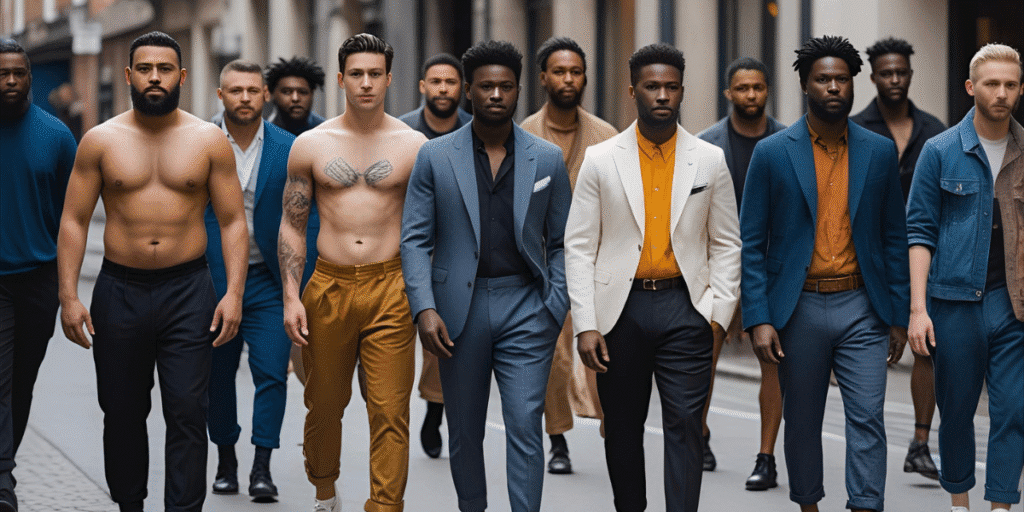In 2022, men’s fashion has seen significant evolution, embracing inclusivity across various dimensions—body types, ethnicities, gender expressions, and sustainability. These changes reflect a broader societal shift toward breaking traditional gender norms, with the fashion industry at the forefront of driving this transformation. From high-end designers to streetwear brands, the focus on creating more diverse, gender-neutral collections is changing how men approach fashion. Moreover, sustainability efforts are gaining momentum, with brands introducing eco-conscious collections in response to the growing consumer demand for environmentally friendly fashion choices.
Inclusivity: Breaking Traditional Gender Norms
One of the most notable trends in 2022 is the rise of gender-fluid fashion. Designers and brands are increasingly offering unisex collections that cater to a wide range of body types, ethnicities, and gender identities. This evolution in men’s fashion is part of a larger cultural shift away from rigid gender expectations. The idea that certain clothing styles are exclusively for men is being replaced with more inclusive and flexible choices.
Fashion houses and streetwear brands are pushing boundaries by embracing clothing styles that can be worn by anyone, regardless of gender. This includes oversized fits, innovative cuts, and creative materials that appeal to a diverse group of consumers. Celebrities like Harry Styles and Lil Nas X have contributed to this trend, showcasing gender-neutral fashion choices that challenge traditional views on masculinity. The mainstream acceptance of non-binary fashion has further normalized this evolution, with more brands and designers offering collections that allow for personal expression without adhering to societal norms.
This shift in the fashion landscape isn’t just about clothing styles but also about representation. Many brands have expanded their campaigns to include models of all genders, ethnicities, and body types. As a result, men’s fashion in 2022 is more diverse and inclusive than ever before, allowing individuals to choose pieces that reflect their unique identity.
Embracing Body Positivity and Expanded Sizing
Alongside the rise of gender-fluid fashion, inclusivity in terms of body types has become a central focus. Historically, men’s fashion has been centered around an idealized image of masculinity—thin, muscular, and tall. In 2022, however, brands are expanding their sizing ranges to ensure that men of all body types can find clothing that fits well and makes them feel confident.
The fashion industry’s increasing focus on body positivity is reflected in the extended sizing ranges offered by many popular brands. For example, brands like ASOS have launched extended size collections, recognizing the need to serve men of various shapes and sizes. This move is particularly important as body positivity has gained significant cultural traction, encouraging individuals to embrace their bodies and reject unrealistic beauty standards.
In addition to size inclusivity, advertising campaigns are also becoming more diverse, featuring male models with different body types, skin tones, and backgrounds. This shift is making a statement that all men deserve to feel represented in fashion, regardless of how they look. By reflecting the true diversity of male bodies in campaigns and collections, the fashion industry is helping to break down stereotypes and promote a healthier, more inclusive narrative.
The Rise of Sustainability in Men’s Fashion
2022 also marks an important year for sustainability in men’s fashion. As consumers become more environmentally conscious, there is an increasing demand for clothing that is both stylish and eco-friendly. The fashion industry, known for its significant environmental impact, has been under pressure to improve its practices and reduce waste. Major brands, from global giants like Nike and Adidas to smaller boutique labels, are now prioritizing sustainability in their designs.
Nike, for instance, has embraced sustainability through initiatives like its “Move to Zero” campaign, which aims to reduce carbon emissions and waste throughout its supply chain. The company has started using recycled materials in its products, creating footwear and apparel made from repurposed plastic bottles and other sustainable sources. Similarly, Adidas has introduced eco-conscious collections featuring sustainable fabrics, such as recycled polyester, and is focusing on producing durable products that help minimize waste. The brand has also pledged to ensure that all of its shoes are made from recycled plastic by 2024.
These sustainability efforts are in response to the growing consumer demand for environmentally friendly products. More men are now mindful of how their clothing is made and are choosing to support brands that align with their values. As sustainability becomes a core principle in the fashion industry, brands will continue to innovate, creating clothing that meets both aesthetic and ethical standards.
Changing Consumer Priorities
Today’s fashion-conscious consumers are no longer solely focused on how they look but also on the impact their clothing choices have on the environment. This shift in priorities has led to a demand for transparency in fashion. Consumers want to know where their clothes are made, what materials are used, and whether brands are prioritizing sustainable practices.
As a result, many companies are becoming more transparent about their production processes and sustainability initiatives. This is not just about being eco-friendly; it’s about offering consumers a sense of responsibility and encouraging informed purchasing decisions. The rise of ethical fashion has led to more brands incorporating traceability and environmental certifications into their business models, ensuring that their practices align with consumer expectations.
Conclusion: What’s Next for Men’s Fashion?
Looking forward, it’s clear that inclusivity and sustainability are shaping the future of men’s fashion. As the demand for gender-neutral clothing and diverse body types grows, we can expect more brands to offer collections that cater to a wide range of identities and sizes. Similarly, the push for eco-friendly fashion will continue to gain momentum as consumers demand transparency and responsible production practices. The evolution of men’s fashion in 2022 is more than just a trend; it is a cultural shift toward a more inclusive, conscious, and diverse fashion industry.
